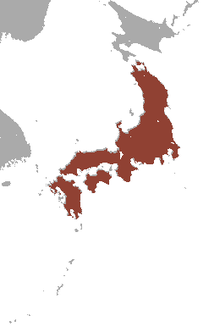Meles anakuma
| Japanese badger | |
|---|---|
 |
|
| At Inokashira Park Zoo (Main Park), Tokyo, Jun 2009 | |
| Scientific classification | |
| Kingdom: | Animalia |
| Phylum: | Chordata |
| Class: | Mammalia |
| Order: | Carnivora |
| Suborder: | Caniformia |
| Family: | Mustelidae |
| Subfamily: | Mustelinae |
| Genus: | Meles |
| Species: | M. anakuma |
| Binomial name | |
|
Meles anakuma Temminck, 1844 |
|
 |
|
| Japanese badger range | |
The Japanese badger (Meles anakuma) is a species of carnivoran of the family Mustelidae, the weasels and their kin. Endemic to Japan, it is found on Honshu, Kyushu, Shikoku, and Shodoshima. It shares the genus Meles with the Asian and European badgers.
Japanese badgers are smaller (average length 79 cm (31 in) in males, 72 cm (28 in) in females) and less sexually dimorphic (except in the size of the canine teeth) than their European counterparts. Tail length is between 14 and 20 cm (5.5 and 7.9 in). This species is rather smaller on average than the European badger but is similar or mildly larger than the Asian badger. Adults usually weigh from 3.8 to 11 kg (8.4 to 24.3 lb). The average weight of female Japanese badgers in one study from the Tokyo area was found to be 6.6 kg (15 lb) while that of males was 7.76 kg (17.1 lb). In the Yamaguchi Prefecture, the average spring weight of female and male Japanese badgers was 4.4 kg (9.7 lb) and 5.7 kg (13 lb). The torso is blunt and limbs are short. The front feet are equipped with powerful digging claws. The claws on hind feet are smaller. The upper coat has long gray-brown hair. Ventral hair is short and black. The face has characteristic black-white stripes that are not as distinct as in the European badger. The dark color is concentrated around the eyes. The skull is smaller than in the European badger.
The absence of badgers from Hokkaido, and the presence of related M. leucurus in Korea, suggest that the ancestral badgers reached Japan from the southwest via Korea. Genetic studies indicate that there are substantial differences between Japanese and Asian badgers, which were formerly considered conspecific, and that the Japanese badgers are genetically more homogenous.
...
Wikipedia

